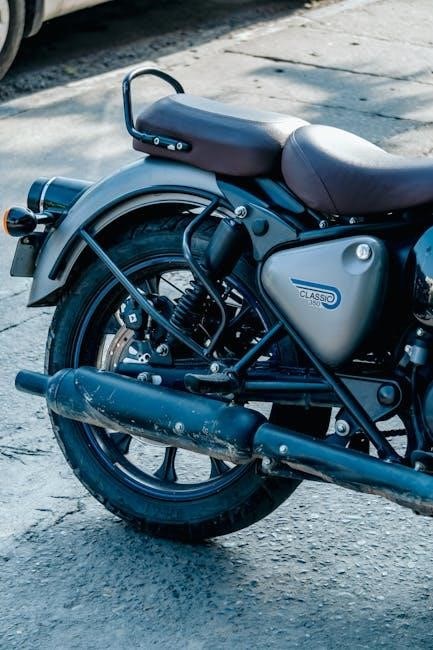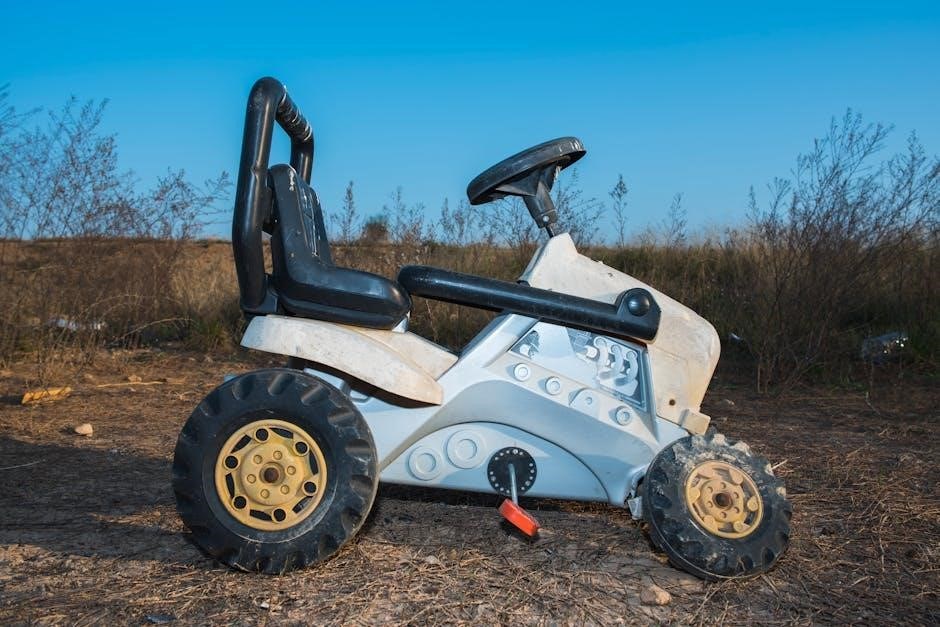A valve seat and guide machine is essential for cylinder head work‚ ensuring precision and efficiency in repairing and maintaining engine components. It plays a crucial role in automotive and industrial engineering‚ providing accurate machining for valve seats and guides to restore engine performance and durability.
1.1 Definition and Purpose
A seat and guide machine is a specialized tool designed to precision-machine valve seats and guides in engine cylinder heads. Its primary purpose is to restore or modify these critical components to ensure proper valve operation‚ sealing‚ and engine performance. By accurately machining these parts‚ the machine helps maintain engine efficiency‚ durability‚ and reliability‚ making it indispensable in automotive and industrial repair workflows.
1.2 Importance in Cylinder Head Work
The seat and guide machine is vital for cylinder head work‚ as it ensures precise machining of valve seats and guides‚ critical for proper engine function. Incorrect or worn valve seats can lead to performance issues‚ such as reduced power‚ poor fuel efficiency‚ or even engine failure. By accurately restoring these components‚ the machine prevents valve-related problems‚ ensuring optimal engine operation and longevity. Its role is indispensable in maintaining engine health and reliability‚ making it a cornerstone tool in automotive and industrial repair workflows.

History and Evolution
The seat and guide machine has evolved from basic manual tools to advanced CNC machines‚ reflecting advancements in engineering and the demand for precision in cylinder head repair.
2.1 Early Development
The early development of seat and guide machines began with rudimentary tools used in the mid-20th century for basic cylinder head repairs. These initial machines were largely manual‚ relying on skilled technicians to perform precise cuts and fits. As automotive engines became more complex‚ the need for specialized tools grew‚ leading to the creation of dedicated machines for valve seat and guide machining. This period laid the foundation for the modern‚ high-precision equipment used today in engine repair shops worldwide.
2.2 Modern Advancements
Modern advancements in seat and guide machines have introduced CNC (Computer Numerical Control) technology‚ enabling precise and automated machining. Digital controls now allow for customizable settings‚ ensuring optimal results. These machines also feature advanced software for real-time monitoring and adjustments‚ improving efficiency and consistency. Additionally‚ modern designs incorporate improved materials and coatings‚ enhancing durability and performance. These innovations have significantly streamlined cylinder head repair processes‚ reducing errors and increasing productivity in automotive and industrial applications. The integration of AI and predictive maintenance further enhances their operational capabilities‚ making them indispensable in contemporary engine repair shops.

Key Components
The valve seat and guide machine includes a valve seat‚ guide machine‚ and other essential parts‚ ensuring precise machining and alignment of engine components for optimal performance.
3.1 Valve Seat
The valve seat is a critical component in cylinder head work‚ designed to provide a precise surface for the valve to seat against‚ ensuring a tight seal. Proper machining of the valve seat is essential for optimal engine performance‚ as it directly affects combustion efficiency and prevents leaks. Incorrectly machined seats can lead to poor engine performance‚ increased emissions‚ and potential damage to the valve train. The seat must be aligned and finished to exact specifications‚ making it a focal point in the operation of seat and guide machines.
3.2 Guide Machine
The guide machine is a specialized tool used to machine and align valve guides in engine cylinder heads. It ensures proper alignment and precise machining of the valve guide‚ critical for maintaining engine performance and longevity. The guide machine works in conjunction with the valve seat machine‚ ensuring that both components are accurately fitted and aligned. This dual function is essential for preventing wear‚ improving combustion efficiency‚ and reducing emissions. Proper use of the guide machine is vital for achieving optimal engine operation and durability.
3.3 Other Essential Parts
Beyond the valve seat and guide machine‚ several other components are vital for optimal functionality. These include pilot bushes‚ which ensure accurate alignment‚ and cutting tools designed for precise machining. The drive mechanism powers the machine‚ while cooling systems prevent overheating during operation. Additionally‚ clamping fixtures securely hold the cylinder head in place‚ ensuring stability. These parts collectively contribute to the machine’s efficiency‚ accuracy‚ and durability‚ making them indispensable in cylinder head repair and maintenance processes.

How It Works
A seat and guide machine operates by precision-machining valve seats and guides in cylinder heads. It clamps the head securely‚ using specialized tools to achieve accurate results.
4.1 General Overview
A seat and guide machine is designed to restore engine cylinder heads by machining valve seats and guides to precise specifications. The process involves clamping the cylinder head securely‚ aligning the machine to the valve seat‚ and using cutting tools to achieve the desired surface finish. This ensures proper valve sealing‚ reduces wear‚ and restores engine performance. The machine operates with high precision‚ making it indispensable for automotive and industrial repairs. Skilled operators use these machines to guarantee accuracy and efficiency in cylinder head overhaul operations‚ ensuring optimal engine functionality.
4.2 Detailed Process
The detailed process begins with clamping the cylinder head securely on the machine. The valve seat is aligned using a pilot‚ ensuring precise concentricity. A cutting tool is then fed into the seat‚ removing metal to achieve the desired dimensions. The process includes measuring the seat width‚ angle‚ and depth. After machining‚ the surface is finished to a high standard. Finally‚ the valve guide is inspected and replaced if necessary‚ ensuring proper alignment and sealing. This step-by-step process ensures optimal performance and longevity of the engine’s cylinder head.
Types of Seat and Guide Machines
Seat and guide machines include manual‚ automatic‚ and specialized models. Each is designed for specific tasks‚ ensuring efficiency and accuracy in engine repair and maintenance.
5.1 Manual Machines
Manual seat and guide machines are cost-effective tools for small-scale or custom cylinder head work. They offer precision and control‚ ideal for precise valve seat machining. These machines are often used in smaller workshops or for specific‚ detailed tasks. While they require more time and effort compared to automatic models‚ they provide flexibility and adaptability for unique engine repair needs. Manual machines are preferred for their simplicity and ease of use‚ making them a practical choice for technicians who value hands-on control over the machining process.
5.2 Automatic Machines
Automatic seat and guide machines represent the pinnacle of modern engineering‚ offering high-speed and precise machining for cylinder heads. These advanced tools are designed for large-scale production and high-volume workshops‚ delivering consistent results with minimal operator intervention. Equipped with cutting-edge technology‚ automatic machines ensure faster turnaround times and superior accuracy. They are ideal for automotive manufacturers and industrial settings where efficiency and reliability are paramount. By automating the machining process‚ these machines reduce human error and increase productivity‚ making them indispensable in today’s fast-paced manufacturing environments.
5.3 Specialized Machines
Specialized seat and guide machines are tailored for unique applications‚ offering customized solutions for specific industries or materials. These machines are designed to handle intricate or unusual cylinder head configurations‚ such as those found in high-performance engines or niche industrial applications. They often feature advanced customization options‚ enabling precise adjustments for particular valve seat and guide requirements. Specialized machines are essential for industries requiring highly specific machining capabilities‚ ensuring optimal performance and durability in unique or challenging environments. Their adaptability makes them invaluable for workshops catering to specialized automotive‚ marine‚ or heavy machinery sectors.

Applications
Seat and guide machines are primarily used in the automotive industry for cylinder head repairs‚ ensuring precise valve seat and guide machining. They also serve industrial engineering and niche applications requiring high-precision engine component maintenance.
6.1 Automotive Industry
In the automotive sector‚ seat and guide machines are indispensable for cylinder head repairs. They enable precise machining of valve seats and guides‚ critical for engine performance. These machines ensure proper valve sealing‚ reduce leaks‚ and restore compression. Automotive workshops rely on them to handle various engine types‚ from passenger vehicles to heavy-duty trucks. Their use minimizes downtime and ensures engines run efficiently‚ making them a cornerstone in automotive maintenance and repair operations worldwide.
6.2 Industrial Engineering
In industrial engineering‚ seat and guide machines are vital for maintaining large-scale machinery and engines. They ensure precision machining of valve seats and guides‚ crucial for industrial equipment durability; These machines are used in manufacturing plants‚ power generation‚ and marine engines‚ where high performance and reliability are essential. By enabling accurate repairs‚ they minimize operational downtime and extend equipment lifespan‚ making them indispensable in industrial settings for maintaining efficiency and productivity.
6.3 Other Niche Applications
Seat and guide machines also find applications in niche industries such as marine engineering‚ aerospace‚ and small engine repair. They are used to precision-machine valve seats and guides for specialized equipment‚ ensuring optimal performance. Additionally‚ these machines are utilized in custom engine builds and vintage engine restoration‚ where precise tolerances are critical; Their versatility extends to industrial plants and heavy machinery‚ making them indispensable in various specialized contexts where engine reliability is paramount. This broadens their utility beyond mainstream automotive and industrial uses.
Maintenance and Repair
Regular maintenance is crucial for optimal functionality. Cleaning‚ lubricating moving parts‚ and replacing worn components ensure precision. Proper alignment is essential for accurate results and longevity.
7.1 Regular Maintenance Tips
Regular maintenance is vital to ensure the longevity and precision of seat and guide machines. Clean the machine thoroughly after each use to remove debris and metal shavings. Lubricate moving parts regularly to prevent wear and tear. Check alignment and calibration frequently to maintain accuracy. Inspect cutting tools and replace them when worn. Follow the manufacturer’s guidelines for maintenance schedules. Store the machine in a dry‚ cool environment to prevent rust. Perform routine checks on electrical components to ensure proper function. Proper upkeep ensures consistent performance and reduces the need for costly repairs.
7.2 Common Repairs
Common repairs for seat and guide machines often involve replacing worn cutting tools‚ pilot bushings‚ and cutter pilots. Misalignment issues may require adjusting or replacing spindle bearings. Regularly inspect and replace seals to prevent oil leakage. Addressing these issues promptly prevents major overhauls. Always use genuine parts for replacements to ensure optimal performance. Proper repair techniques can extend the machine’s lifespan and maintain precision. Regular inspections help identify potential problems early‚ minimizing downtime and repair costs. Timely interventions ensure the machine continues to function accurately and efficiently‚ critical for high-quality cylinder head work.

Safety Precautions
Always wear protective gear‚ including gloves and safety glasses‚ when operating a seat and guide machine. Ensure proper ventilation to avoid inhaling metal dust and debris. Keep loose clothing tied back and avoid jewelry that could get caught in moving parts. Never leave the machine unattended while in operation. Follow manufacturer guidelines for tool usage and maintenance to prevent accidents. Regularly inspect equipment for wear and tear to ensure safe functioning. Proper training is essential to handle the machine safely and effectively‚ minimizing risks of injury or damage.
8.1 Operating Safety
Operating a seat and guide machine requires strict adherence to safety protocols. Always wear protective gear‚ including safety glasses and gloves‚ to prevent injury from flying debris. Ensure the workspace is well-ventilated to avoid inhaling metal dust. Keep loose clothing and jewelry tied back to prevent entanglement. Never operate the machine without proper training‚ and follow the manufacturer’s instructions carefully. Regularly inspect the machine for wear and tear‚ and ensure all guards are in place. Maintain a clean workspace to reduce tripping hazards. Emergency stop buttons should be easily accessible in case of unexpected issues. Prioritize caution to minimize risks during operation.
8.2 Handling Precautions
When handling a seat and guide machine‚ always exercise caution to avoid accidents. Ensure the machine is turned off before adjusting or servicing it. Use proper lifting techniques to prevent strain or injury when moving components. Avoid touching sharp edges or newly machined surfaces to prevent cuts. Keep hands and tools away from moving parts during operation. Store machine components in a secure‚ dry location to prevent damage or rust. Use appropriate lifting equipment for heavy parts‚ and never leave tools or materials unattended near the machine. Proper handling ensures safety and prolongs the machine’s lifespan.

Troubleshooting Common Issues
Common issues with seat and guide machines include improper alignment‚ tool wear‚ and inconsistent finishes. Regular calibration and timely replacement of worn parts ensure optimal performance and longevity.
9.1 Identifying Problems
Identifying issues with seat and guide machines requires attention to operational irregularities. Common problems include misalignment‚ tool wear‚ and vibration. Operators should monitor for uneven finishes‚ excessive noise‚ or temperature fluctuations. Misalignment can lead to improper seating‚ while worn tools cause inconsistent machining. Regular inspections and performance checks help detect issues early‚ preventing costly repairs; Understanding error signs ensures timely intervention‚ maintaining machine efficiency and precision in cylinder head work. Early detection is crucial for extending equipment lifespan and ensuring high-quality outcomes in automotive and industrial applications.
9.2 Solutions and Fixes
To address issues with seat and guide machines‚ start with alignment checks and recalibration. Replace worn tools and ensure proper cutting tool geometry. Address vibration by balancing components and securing mounts. Lubrication and cooling systems should be inspected to prevent overheating. Regular maintenance‚ including cleaning and part replacement‚ can resolve many operational issues. For complex problems‚ consulting the machine’s manual or seeking expertise from manufacturers is recommended. Timely fixes ensure precision‚ extending equipment lifespan and maintaining optimal performance in cylinder head work. Proper troubleshooting enhances reliability and output quality.
Market Trends
The demand for seat and guide machines is rising‚ driven by advancements in automotive and industrial engineering. Current trends focus on precision and efficiency‚ with growing interest in automated solutions to meet increasing production demands. Future projections suggest continued growth‚ supported by technological innovations and expanding applications in niche markets.
10.1 Current Demand
The current demand for seat and guide machines is steadily increasing‚ driven by the growing need for precision in automotive and industrial engineering. As industries seek to enhance engine performance and durability‚ these machines have become indispensable tools. The rising popularity of automated and specialized machinery further fuels the market‚ with manufacturers investing in advanced technologies to meet customer demands. Additionally‚ the expansion of niche applications in various sectors has contributed to the upward trend in sales and adoption of these machines globally.
10.2 Future Projections
The future of seat and guide machines looks promising‚ with advancements in AI and automation expected to redefine their capabilities. As industries prioritize precision and efficiency‚ demand for high-tech machinery will rise. Integration with digital tools and machine learning will enhance performance‚ making these machines indispensable in automotive and industrial sectors. Sustainability practices and eco-friendly designs are also anticipated to drive innovation. With ongoing research and development‚ the market is projected to expand‚ offering advanced solutions tailored to meet evolving industry needs and customer expectations.

Choosing the Right Machine
Selecting the right seat and guide machine involves considering efficiency‚ accuracy‚ and durability. Ensure the machine aligns with your specific needs for cylinder head work. Research and compare models‚ focusing on features that enhance performance and reliability. Consulting experts or product reviews can provide valuable insights to make an informed decision.
11.1 Factors to Consider
When selecting a seat and guide machine‚ evaluate factors like machining precision‚ compatibility with various engine types‚ and ease of operation. Consider the machine’s durability‚ maintenance requirements‚ and cost. Additionally‚ assess the availability of spare parts and manufacturer support. The machine’s ability to handle different materials and valve sizes is crucial. Ensure it meets safety standards and integrates with your workshop’s existing tools. Prioritize features that enhance efficiency and reduce downtime‚ ensuring long-term reliability and performance for cylinder head work.
11.2 Brand and Quality
Choosing a reputable brand ensures reliability and durability. Look for manufacturers with a proven track record in producing high-quality seat and guide machines. Consider certifications like ISO‚ which guarantee adherence to industry standards. While cheaper alternatives may exist‚ investing in a well-known brand often yields better long-term performance. Research customer reviews and ask for recommendations to ensure the machine meets your specific needs. A reliable brand will provide consistent results‚ reducing downtime and ensuring precise cylinder head repairs. Quality is paramount for maintaining engine performance and longevity.

Case Studies
A leading automotive workshop implemented a high-quality seat and guide machine‚ significantly improving cylinder head repair efficiency and reducing operational costs through precise machining capabilities.
12.1 Successful Implementations
Seat and guide machines have proven indispensable in real-world applications‚ particularly in automotive workshops and industrial settings. A notable case involves a leading automotive repair shop that integrated an advanced seat and guide machine‚ achieving a 30% reduction in cylinder head repair time. Additionally‚ a heavy-duty diesel engine manufacturer reported improved Consistency in valve seat machining‚ leading to enhanced engine performance and reduced maintenance costs. Such success stories highlight the machine’s role in streamlining processes and ensuring precision‚ solidifying its reputation as a vital tool in modern engineering.
12.2 Lessons Learned
Implementing seat and guide machines has taught valuable lessons about precision‚ maintenance‚ and operator training. Proper setup and calibration are crucial to avoid costly errors. Regular lubrication of moving parts and timely replacement of worn tools ensure optimal performance. Additionally‚ understanding material compatibility prevents premature wear. Training operators on correct techniques minimizes downtime and enhances safety. These lessons underscore the importance of thorough preparation and ongoing upkeep to maximize the machine’s efficiency and extend its operational life‚ ensuring reliable results in cylinder head repairs and engine maintenance.

Environmental Impact
Eco-friendly practices are crucial for seat and guide machines‚ emphasizing sustainable materials and energy-efficient operation to minimize environmental footprint while maintaining high performance and durability.
13.1 Eco-Friendly Practices
Eco-friendly practices for seat and guide machines involve using sustainable materials and energy-efficient technologies to minimize environmental impact. Manufacturers are adopting green manufacturing processes to reduce waste and emissions. Recycling metal shavings and optimizing coolant usage are common strategies. Additionally‚ biodegradable coolants and low-VOC coatings are being implemented. These practices not only align with environmental regulations but also enhance the machine’s longevity and performance. By prioritizing sustainability‚ the industry reduces its carbon footprint while maintaining high standards of quality and efficiency.
13.2 Sustainable Solutions
Sustainable solutions for seat and guide machines focus on reducing environmental impact through innovative technologies and responsible practices. Manufacturers are integrating renewable energy sources and recycling programs to minimize waste. Advanced machining techniques reduce material consumption and emissions. Additionally‚ the use of biodegradable lubricants and energy-efficient motors contributes to a greener production process. These solutions not only benefit the environment but also enhance cost-effectiveness and compliance with global sustainability standards‚ ensuring a balance between industrial progress and ecological preservation.
A seat and guide machine is indispensable in cylinder head work‚ ensuring precision and durability. Its evolution and sustainable practices highlight its vital role in modern engineering and environmental stewardship.
14.1 Summary of Key Points
A seat and guide machine is a critical tool for cylinder head work‚ ensuring precision and durability in engine repairs. Its applications span automotive and industrial fields‚ with regular maintenance essential for optimal performance. Advances in technology have enhanced its efficiency‚ while eco-friendly practices underscore its role in sustainable engineering. Proper operation and safety precautions are vital to maximize its benefits and longevity‚ making it a cornerstone in modern mechanical workflows and environmental stewardship.



